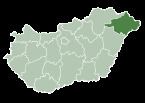Disestablished 1920 1910 319,818 | Established 11th century 1910 4,637 km (1,790 sq mi) | |
 | ||
Hail szabolcs county hungary 2016 06 21
Szabolcs was an administrative county (comitatus) of the Kingdom of Hungary in present-day northeastern Hungary. The capital of the county was Nyíregyháza.
Contents
Geography
Szabolcs county shared borders with the counties Borsod, Zemplén, Ung, Bereg, Szatmár, Bihar and Hajdú. It was situated mostly south of the river Tisza. Its area was 4637 km² around 1910.
History
Szabolcs is one of the oldest counties of the Kingdom of Hungary. After World War I, it was merged with a very small part of former Ung County to form Szabolcs-Ung county, with capital Nyíregyháza. But, villages of Eszeny (present-day Esen) Szalóka (present-day Solovka) and Tiszaágtelek (present-day Tisaahtelek) at Tisza district were passed to Czechoslovakia. These villages were returned to Hungary between 1938 and 1944 but were passed to Soviet Union in 1945. Now, they are part of Ukraine after 1991. After World War II, the county was merged with the Hungarian parts of Szatmár and Bereg counties to form Szabolcs-Szatmár-Bereg county. Some parts of Szabolcs county (around Polgár and north-east of Debrecen) are now in Hajdú-Bihar county.
1880
In 1880, the county had a population of 214,008 people and was composed of the following linguistic communities:
Total:
According to the census of 1880, the county was composed of the following religious communities:
Total:
1900
In 1900, the county had a population of 288,672 people and was composed of the following linguistic communities:
Total:
According to the census of 1900, the county was composed of the following religious communities:
Total:
1910
In 1910, the county had a population of 319,818 people and was composed of the following linguistic communities:
Total:
According to the census of 1910, the county was composed of the following religious communities:
Total:
Subdivisions
In the early 20th century, the subdivisions of Szabolcs county were:
